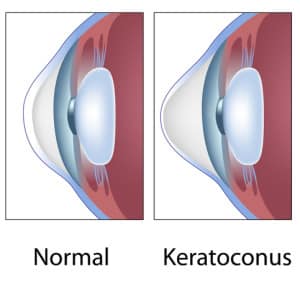
Keratoconus is an uncommon condition in which the normally round, dome-like cornea (the clear front window of the eye) becomes thin and develops a cone-like bulge. Keratoconus literally means “cone-shaped cornea.”
The cornea is a very important part of your eye. Light enters the eye through the cornea, which refracts, or focuses, the light rays so that you can see clearly. With keratoconus, the shape of the cornea is altered, distorting your vision. Keratoconus can make some activities difficult, such as driving, typing on a computer, watching television or reading.
Causes of keratoconus include:
- An eye injury – excessive eye rubbing or wearing hard contact lenses for many years.
- Certain eye diseases – including retinitis pigmentosa, retinopathy of prematurity and vernal keratoconjunctivitis.
- Systemic diseases – such as Leber’s congenital amaurosis, Ehlers-Danlos syndrome, Down Syndrome and osteogenesis imperfecta.
Symptoms
Keratoconus usually affects both eyes, though symptoms in each eye may differ. Symptoms usually start to occur in people who are in their late teens and early 20s and may include:
- Blurring of vision
- Distortion of vision
- Increased sensitivity to light
- Glare
- Mild eye irritation
Keratoconus Treatment
Keratoconus treatment often depends on the severity of the symptoms. During early stages, vision can be corrected with eyeglasses. As the condition progresses, rigid contacts may need to be worn so that light entering the eye is refracted evenly and vision is not distorted. You should also refrain from rubbing your eyes, as this can aggravate the thin corneal tissue and make symptoms worse.
Another treatment option for keratoconus that is not FDA approved is collagen cross-linking. Collagen cross-linking is a new treatment that uses a special laser and eyedrops to promote “cross-linking” or strengthening of the collagen fibers that make up the cornea. This treatment may flatten or stiffen the cornea, preventing further protrusion.
When good vision is no longer possible with other treatments, a corneal transplant may be recommended. This surgery is only necessary in about 10 percent to 20 percent of patients with keratoconus. In a corneal transplant, the diseased cornea is removed from your eye and replaced with a healthy donor cornea.
A transplanted cornea heals slowly. It can take up to a year or more to recover good vision after corneal transplantation. While a corneal transplant will relieve the symptoms of keratoconus, it may not provide you with flawless vision; however, of all conditions requiring corneal transplants, keratoconus has a lower rejection rate and the best prognosis for clear vision.
Our Contact Lens department and Surgeons are skilled in taking care of patients with Keratoconus. Please call and schedule a consultation today at the Takle Eye Group with one of our providers at 770-228-3836




